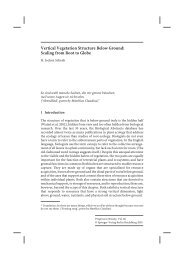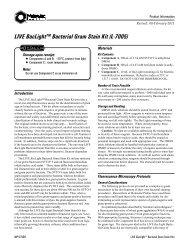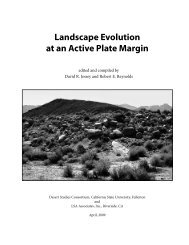Chitons (Mollusca: Polyplacophora) - Biological Science - California ...
Chitons (Mollusca: Polyplacophora) - Biological Science - California ...
Chitons (Mollusca: Polyplacophora) - Biological Science - California ...
You also want an ePaper? Increase the reach of your titles
YUMPU automatically turns print PDFs into web optimized ePapers that Google loves.
Vol. XLI(6): 2009 THE FESTIVUS Page 63<br />
S<br />
Setae long, stout and bearing sharply pointed white or yellow tinged spicules that entirely encircle the shaft;<br />
central areas without distinct longitudinal riblets, appearing pitted with outwardly curving ribbing crossed by<br />
more or less finer lateral riblets, although some ribbing may appear less curved and more longitudinally<br />
pronounced in juveniles; head valve with 7-10 coarsely nodulose radial ribs, lateral areas with similar diagonal<br />
and sutural ribs, nodules distinctly separate, interspaces between heavy ribs of head valve and lateral areas of<br />
intermediate valves with irregular, radiating rows of elongated granules ............. Mopalia lowei<br />
Results<br />
We report 19 species of chitons from mostly deepwater<br />
habitats ranging throughout the SCB, including 16<br />
described and three provisional (undescribed) species<br />
(Table 2). A fourth possible new species is also reported<br />
based on a single small juvenile. The chitons reported<br />
were collected between 1988 and 2009 at 66 different<br />
sampling sites ranging from northern Baja <strong>California</strong> to<br />
the northern Channel Islands and Point Conception<br />
(Figure 1, Appendix A). Several species are distributed<br />
widely throughout the region, while others are so far<br />
restricted to one or a few locations. Most individuals<br />
were collected from depths between 30 and 305 m,<br />
which were the primary focus of this study. Records for<br />
a few species collected from slightly shallower waters<br />
(9-18 m) by SCB benthic monitoring programs are also<br />
included because we expect these will eventually be<br />
found in deeper water. As in Eernisse (1998), we found<br />
the chiton fauna at the depths sampled herein to be<br />
largely distinct in comparison to the species commonly<br />
found in either shallower or deeper waters. Information<br />
is presented below for each species regarding their<br />
relative abundance, size, geographic distribution,<br />
bathymetric range, and co-occurrence with other chitons<br />
in the region.<br />
Family Leptochitonidae Dall, 1889<br />
Hanleyella oldroydi (Bartsch MS, Dall, 1919)<br />
(Plate 1, Figure 2)<br />
Hanleyella oldroydi is reported to occur along the<br />
West Coast from Kosciusko Island, Alaska to Cabo San<br />
Quintin, Baja <strong>California</strong> at depths ranging from 18 to<br />
455 m (Ferriera, 1979b; Baxter, 1983; Kaas & Van<br />
Belle, 1985a; Eernisse, 1998). This species was one of<br />
the most commonly encountered chitons in the present<br />
study, occurring in ~22% of the SCB samples<br />
containing chitons. All H. oldroydi examined in this<br />
study were collected in deep waters ranging from 50 to<br />
191 m at sites located off of San Diego, Palos Verdes,<br />
Santa Monica Bay and the northern Channel Islands. A<br />
total of 26 specimens of H. oldroydi have been<br />
examined so far, representing approximately 11% of the<br />
chitons collected. The maximum length of SCB<br />
specimens is 7.4 mm (mean = 4.2 mm), which is<br />
consistent with published records for this small species<br />
(see Ferreira, 1979b; Kaas & Van Belle, 1985a).<br />
Hanleyella oldroydi is commonly collected in samples<br />
with another lepidopleurid, Leptochiton rugatus,<br />
although the bathymetric range for the latter species<br />
includes the intertidal (see below). Other chitons<br />
collected at the same sites include Leptochiton nexus,<br />
Lepidozona radians, L. mertensii, L. retiporosa, L.<br />
scrobiculata, and possibly three undescribed species<br />
(Lepidozona spp. A and C, and Leptochiton sp.).<br />
Leptochiton nexus Carpenter, 1864<br />
(Plate 1, Figure 3)<br />
Leptochiton nexus is known to occur along the West<br />
Coast from Cohen Island, Alaska to Punta Abreojos,<br />
Baja <strong>California</strong>, as well as in the Gulf of <strong>California</strong> at<br />
depths ranging from the intertidal to 144 m (Ferriera,<br />
1979b; Kaas & Van Belle, 1985a). This chiton is<br />
reported here for the SCB from seven specimens<br />
collected at six sites located off of San Diego, Palos<br />
Verdes, Santa Monica Bay and the northern Channel<br />
Islands at depths of 18-82 m. The maximum length of<br />
the SCB specimens is 9.3 mm (mean = 5.9 mm), which<br />
is less than half the size that L. nexus typically reaches<br />
(see Ferreira, 1979b; Kaas & Van Belle, 1985a). Other<br />
chitons collected with L. nexus in the present study<br />
include Hanleyella oldroydi, Leptochiton rugatus, and<br />
Lepidozona retiporosa.<br />
Leptochiton rugatus (Carpenter in Pilsbry, 1892)<br />
(Plate 1, Figure 4)<br />
Certain recent authors (Ferreira, 1979b; Kaas &<br />
Van Belle, 1985a) have considered Leptochiton rugatus<br />
(Carpenter in Pilsbry, 1892) to be widely distributed
















